A New Extended Jacobi Elliptic Function Expansion Method and Its Application to the Generalized Shallow Water Wave Equation
Abstract
With the aid of symbolic computation, a new extended Jacobi elliptic function expansion method is presented by means of a new ansatz, in which periodic solutions of nonlinear evolution equations, which can be expressed as a finite Laurent series of some 12 Jacobi elliptic functions, are very effective to uniformly construct more new exact periodic solutions in terms of Jacobi elliptic function solutions of nonlinear partial differential equations. As an application of the method, we choose the generalized shallow water wave (GSWW) equation to illustrate the method. As a result, we can successfully obtain more new solutions. Of course, more shock wave solutions or solitary wave solutions can be gotten at their limit condition.
1. Introduction
In recent years, the nonlinear partial differential equations (NPDEs) are widely used to describe many important phenomena and dynamic processes in physics, mechanics, chemistry, biology, and so forth. With the development of soliton theory, There has been a great amount of activities aiming to find methods for exact solutions of nonlinear differential equations, such as Bäcklund transformation, Darboux transformation, Cole-Hopf transformation, similarity reduction method, variable separation approach, Exp-function method, homogeneous balance method, varied tanh methods, and varied Jacobi elliptic function methods [1–21].
Among those, the direct ansätz method [8–21] provides a straightforward and effective algorithm to obtain such particular solutions for a large number of nonlinear partial differential equations, in which the starting point is the ansätz that the solution sought is expressible as a finite series of special function, such as tanh function, sech function, tan function, sec function, sine-cosine function, Weierstrass elliptic function, theta function, and Jacobi elliptic function.
In this paper, a new Jacobi elliptic function expansion method is presented by means of a new general ansätz and is more powerful to uniformly construct more new exact doubly-periodic solutions in terms of Jacobi elliptic functions of nonlinear partial differential equations. The algorithm and its application are demonstrated later.
This paper is organized as follows. In Section 2, we summarize the extended Jacobi elliptic function expansion method. In Section 3, we apply the extended method to the generalized shallow water wave (GSWW) equation and bring out more new solutions. Conclusions will be presented in finally.
2. Summary of the Extended Jacobi Elliptic Function Expansion Method
In the following, we would like to outline the main steps of our extended method.
Step 1. For a given nonlinear partial differential equation with some physical fields u(x, y, t) in three variables x, y, t,
Step 2. We introduce some new ansätz in terms of finite Jacobi elliptic function expansion in the following forms:
- (1)
sn′ξ/snξ expansion:
(2.4a) - (2)
cn′ξ/cnξ expansion:
(2.4b) - (3)
dn′ξ/dnξ expansion:
(2.4c)
Step 3. In order to obtain the value of n in (2.4a)–(2.4c), we define the degree of u(ξ) as D[u(ξ)] = n, which gives rise to the degree of other expressions as
Step 4. Respectively substitute three cases of (2.4a)–(2.4c) into (2.3) along with (2.5) and (2.6) and then respectively set all coefficients of sniξcnjξdnkξ (i = 0,1, 2, …; j = 0,1; k = 0,1) to be zero to get an overdetermined system of nonlinear algebraic equations with respect to a0, ai, bi, k, l, c (i = 0,1, 2, …).
Step 5. By use of the Maple software package “Charsets” by Dongming Wang, which is based on the Wu-elimination method [24], solving the overdetermined algebraic equations, we would end up with the explicit expressions for a0, ai, bi, k, l, c (i = 0,1, 2, …). In this way, we can get periodic solutions with Jacobi elliptic function.
Since
So the new extended Jacobi elliptic function expansion method can obtain more new solutions, which contain solitary wave solutions, singular solitary solutions, and triangular function solutions. These new solutions cannot be obtained by other Jacobi elliptic function methods, such as Fu et al. [13], Fan [14], Yan [15–17], and Chen et al. [18–21].
3. Exact Solutions of the GSWW Equation
The GSWW equation (3.1) in potential form was studied by Clarkson and Mansfield [26, 29] who gave a complete catalog of classical and nonclassical symmetry reductions. The necessary conditions of Painlevé tests were given by Weiss et al. [30] and the complete integrability of (3.1) for the case when α = 2β and α = β was established by Ablowitz et al. [31]. It has been proven by Hietarinta [32] that the GSWW equation (3.2) can be expressed in Hirota’s bilinear form and when α = 2β, (3.2) can be reduced to (3.3) or to (3.4) when α = β. In other words, both (3.3) and (3.4) are solvable by using Hirota’s bilinear method [33]. The N-soliton solutions for (3.3) and (3.4) had also been found using this technique [28]. Although there is no scaling transformation that can reduce (3.3) to (3.4), the classical methods of Lie, the nonclassical method of Bluman and Cole, and the direct method of Clarkson and Kruskal can be applied to solve the GSWW equation (3.2) to obtain some kinds of symmetry reductions [34, 35]. Recently, Elwakil found a lot of exact solutions by using the modified extended tanh-function method [36]. Yang and Hon employed a rational expansion to generalize Fan’s method for exact travelling wave solutions for the generalized shallow water wave (GSWW) equation [37].
Now we consider the system (3.7) in the above three cases, so that (2.4a)–(2.4c). According to Step 2 and Step 3 in Section 2, by balancing the nonlinear term U2 with the highest-order differential term U′′ in (3.7), we suppose that (3.7) has the following formal solutions.
3.1. sn′ξ/snξ Expansion
With the aid of Maple, substituting (3.8) along with (2.5) and (2.6) into (3.7), yields a set of algebraic equations for sniξcnjξdnkξ (i = 0,1, 2, …; j = 0,1; k = 0,1). Setting the coefficients of these terms sniξcnjξdnkξ to be zero yields a set of overdetermined algebraic equations with respect to a0, a1, a2, b1, b2, k, l, and c.
By use of the Maple software package “Charsets” by Dongming Wang, which is based on the Wu-elimination method [24], solving the overdetermined algebraic equations, we get the following results.
Case 1.
Case 2.
Case 3.
Case 4.
Case 5.
Family 1. From (3.9), we obtain the following sn′ξ/snξ expansion solutions for the GSWW equation as follows:
Family 2. From (3.10), we obtain the following sn′ξ/snξ expansion solutions for the GSWW equation as follows:
Family 3. From (3.11), we obtain the following sn′ξ/snξ expansion solutions for the GSWW equation as follows:
Family 4. From (3.12), we obtain the following sn′ξ/snξ expansion solutions for the GSWW equation as follows:
Family 5. From (3.13), we obtain the following sn′ξ/snξ expansion solutions for the GSWW equation as follows:
Family 6. From (3.14), we obtain the following sn′ξ/snξ expansion solutions for the GSWW equation as follows:
Remark 3.1. Here we find that the modulus m of the Jacobi elliptic functions has relations with c and k in Cases 1–6. To further analyze their relations, we take the solutions (3.9), (3.11), and (3.13) as samples by three figures (see Figures 1, 2, and 3).
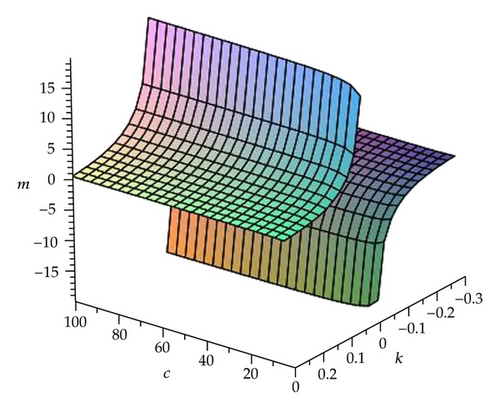
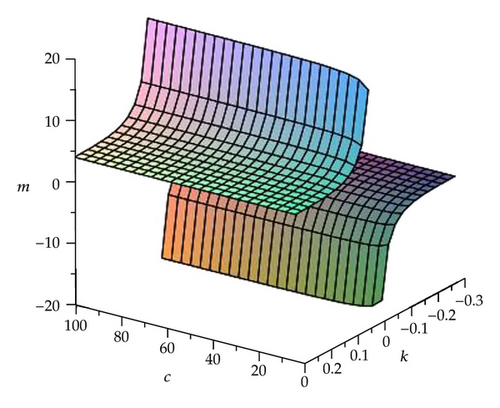
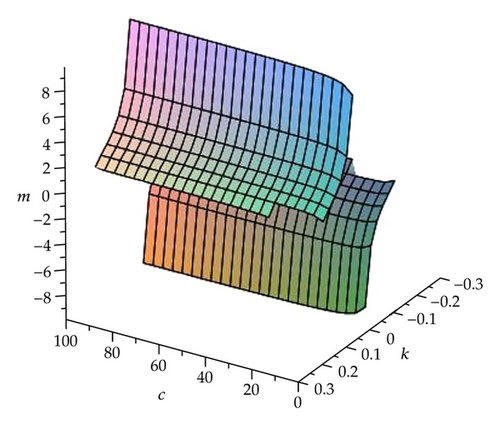
3.2. cn′ξ/cnξ Expansion
Family 7.
Family 8.
Family 9.
Family 10.
Family 11.
Family 12.
3.3. dn′ξ/dnξ Expansion
Family 13.
Family 14.
Family 15.
Family 16.
Family 17.
Family 18.
Remark 3.2. The solutions obtained here, to our knowledge, are all new families of periodic solution of the GSWW equation.
Remark 3.3. In order to understand the significance of these solutions in Families 1 and 18, here we take the solutions (3.15), (3.17), (3.19), (3.22), (3.24), (3.26), (3.29), (3.31), and (3.33) as samples to further analyze their properties by some figures (see Figures 4, 5, 6, 7,8, 9, 10, 11, and 12).
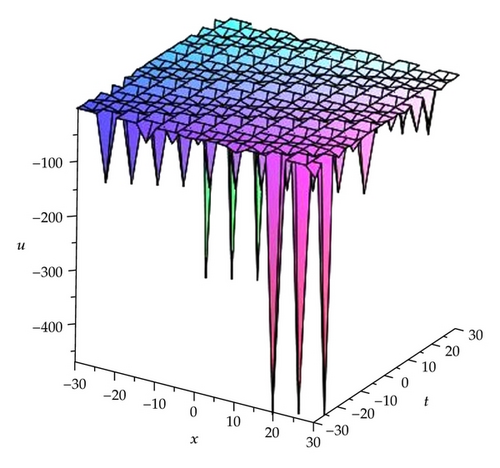
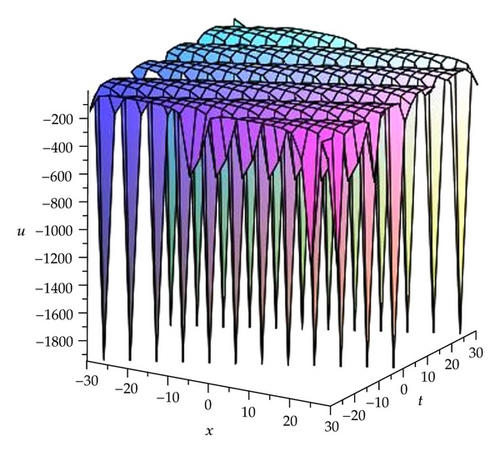
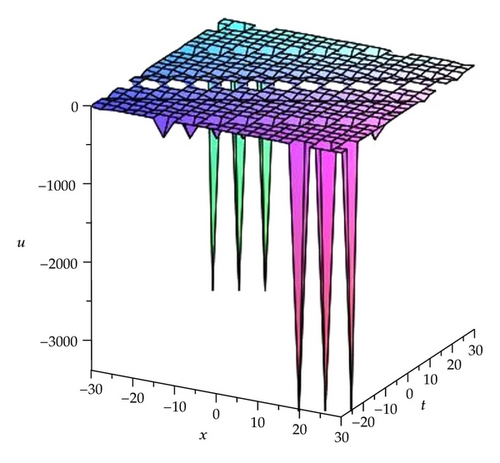
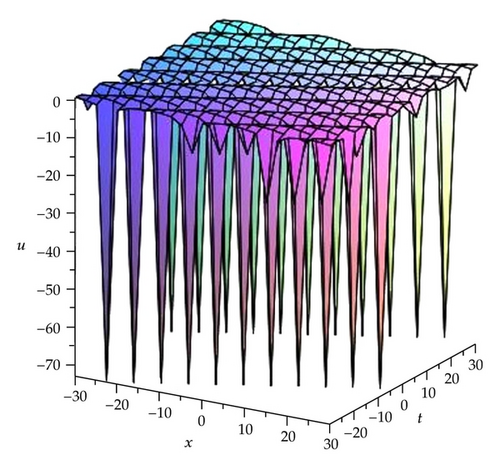
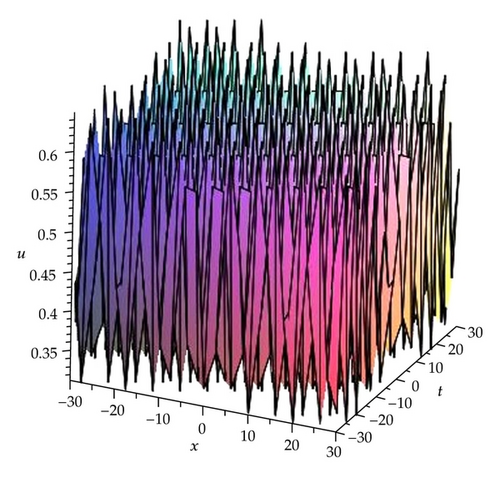
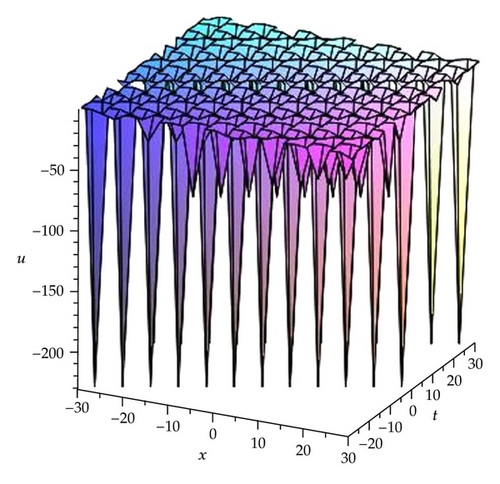
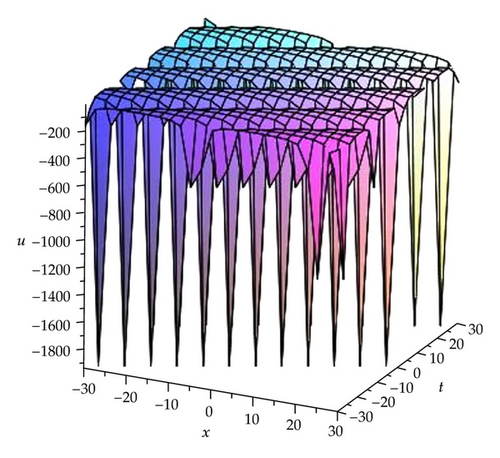
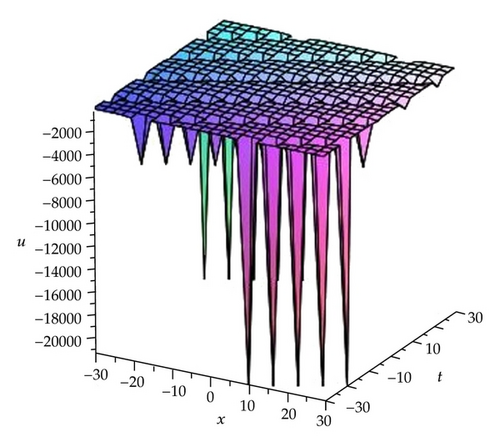
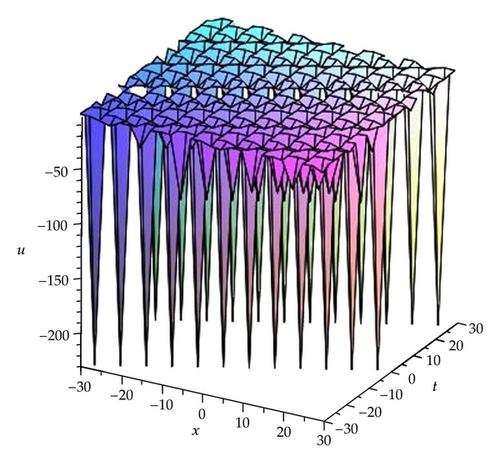
4. Conclusion and More General Form
In short, we have presented the new extended Jacobi elliptic function expansion method. The GSWW equation is chosen to illustrate the method such that many families of new Jacobi elliptic function solutions are obtained. When the modulus m → 1 or 0, some of these obtained solutions degenerate as solitary solutions or trigonometric function solutions. The algorithm can be applied to many nonlinear differential equations in mathematical physics. Other types of solutions of (2.1) need to be studied further.
It is easy to see that above-mentioned method is only applied to these nonlinear ODEs with constant coefficients or nonlinear partial differential equations, which can be reduced to the corresponding nonlinear ODEs with constant coefficients by using some transformations; otherwise, the method will not work. In order to overcome the disadvantage of the method, we change the method into a general form as follows.
- (1)
sn′(ξ)/sn(ξ) expansion:
(4.1a) - (2)
cn′(ξ)/cn(ξ) expansion:
(4.1b) - (3)
dn′ξ/dnξ expansion:
(4.1c)
Conflict of Interests
The authors declare that they have no conflict of interests.
Acknowledgments
Many thanks are due to suggestions from the referees and support from the National Natural Science Foundation of China (Grant no. 61171179) and the Young Scientists Fund of the National Natural Science Foundation of China (Grant no. 10901145).




